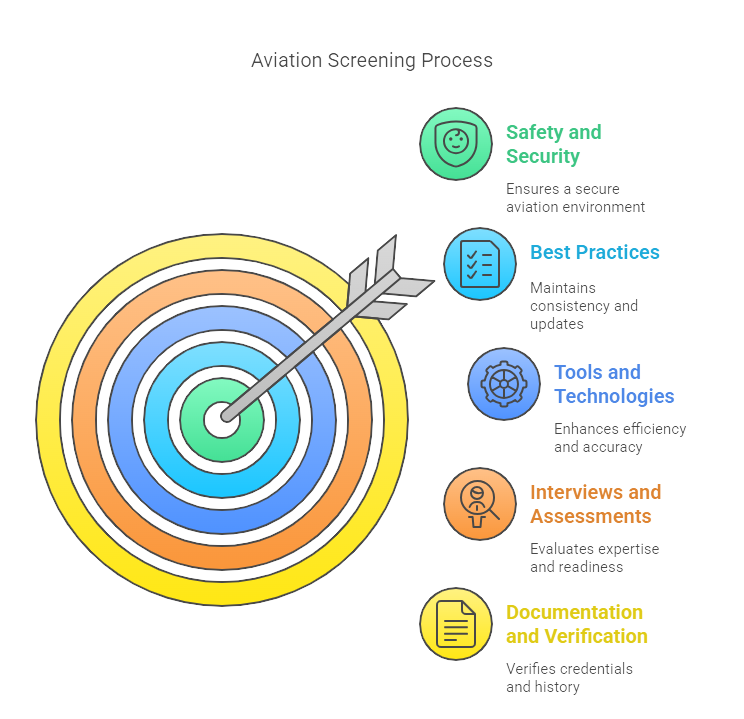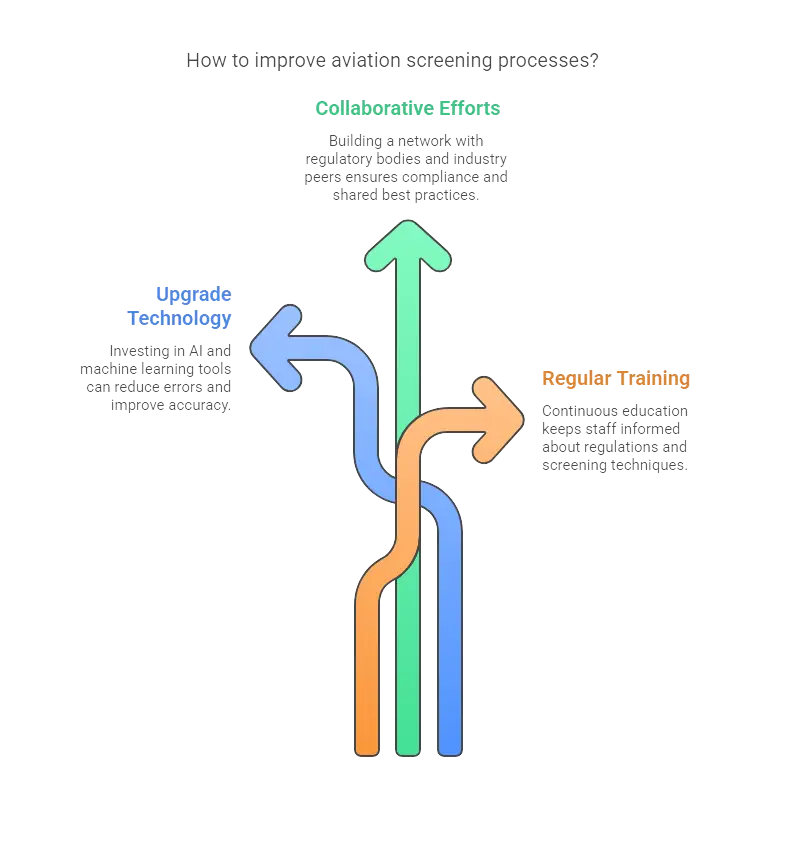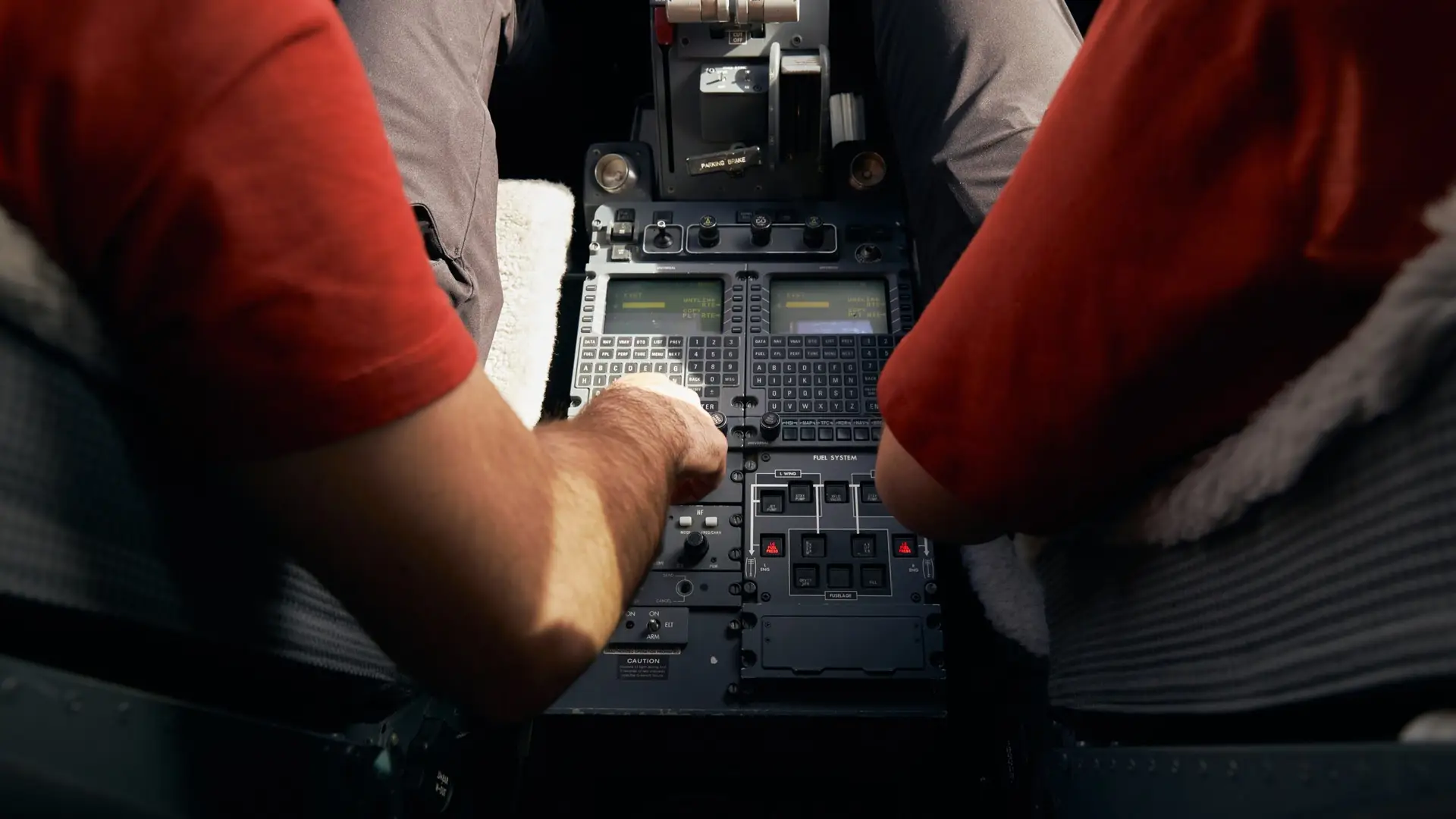Screening in the aviation industry is not just a procedural formality; it's a critical component of ensuring the safety, security, and reliability of air travel. Whether you're an airline executive, an HR professional, a recruiter, or a job seeker aspiring to soar in this high-stakes industry, understanding the intricacies of aviation industry screening is essential. This guide delves into the various facets of aviation screening, offering insights and practical advice to help you navigate the process effectively.
Key Takeaways
- Aviation industry screening is essential for ensuring the safety and security of air travel.
- It involves thorough checks including background, security, medical examinations, and drug testing.
- Adherence to regulations from bodies like the DOL and EEOC is crucial to avoid legal repercussions.
- Technological investment and ongoing training for HR professionals are vital for effective screening.
- Continuous adaptation and vigilance are necessary to address challenges and maintain high safety standards.
Introduction
Safety and security are the lifeblood of the aviation industry. Every time an aircraft takes to the skies, there’s an unseen network of safety protocols and screenings ensuring that both passengers and crew can travel without fear. This invisible shield forms the backbone of the aviation sector, making sure that each flight is a seamless and secure journey.
Aviation industry screening serves as the gatekeeper, meticulously checking every box to maintain this standard. It encompasses everything from background checks and security clearances to medical examinations and drug testing. These processes don't just uphold safety; they are paramount for compliance with regulatory standards and fostering public trust.
This guide aims to unpack the complexity of aviation industry screening. We will traverse through the types of screenings, delve into the legal landscape, weigh the benefits and challenges, and explore best practices for effective implementation. Whether you're on the frontline as an HR professional or a job seeker with dreams of altitude, this comprehensive overview will arm you with the essentials for navigating this critical terrain.

Understanding Aviation Industry Screening
1. What Is Aviation Industry Screening?
Screening in the aviation industry is a multi-faceted process designed to ensure the safety, security, and operational reliability of air travel. On a basic level, it involves assessing potential and current employees in various roles within the aviation sector. The primary aim is to safeguard passengers, crew, and the integrity of the airline operations.
The key objectives of aviation screening include:
- Safety: Ensuring that all personnel, especially crew members and pilots, are physically and mentally fit to perform their duties.
- Security: Verifying that individuals do not pose any security risks, which includes evaluating criminal records, affiliations, and other potential red flags.
- Compliance: Adhering to international and national regulations that govern the aviation industry to avoid legal repercussions and ensure smooth operations.
Key stakeholders involved in aviation screening span multiple layers of the industry:
- Employers and Airlines: Responsible for initiating and conducting the screening processes.
- HR and Recruiters: Handle the specifics of background checks, interviews, and verifications.
- Regulatory Bodies: Organizations like the Federal Aviation Administration (FAA) in the United States, which set and enforce screening standards.
- Job Seekers: Aspiring professionals who must navigate and comply with the screening processes to secure employment.
Aviation industry screening is more than just a function of HR; it's a critical line of defense in maintaining the trust and safety of everyone in the air travel ecosystem. From pilots to ground crew, the process ensures that everyone is up to the mark, creating a safe environment both on and off the ground.
2. Types of Screenings in Aviation
Screening in aviation is multi-faceted and rigorous for good reason. Each type of screening serves a distinct purpose, adding layers of security and efficiency to the industry's operations.
EXPERT INSIGHT: Screening in aviation is never a box-ticking exercise; it is a deep responsibility demanding accuracy, vigilance, and an unremitting commitment to safety. Having coordinated important recruitment initiatives personally, I have seen how thorough vetting doesn’t only protect passengers—it ensures particular passengers will continue to trust each time they take to the skies. As a people professional in human resources, we are custodians of security and peace of mind, ensuring each and every member of our ground and flight deck is appropriate to take on the burden of trust. It is a task that reminds me daily: in aviation, diligence truly saves lives. - Charm Paz, CHRP
Background Checks
Background checks are non-negotiable in aviation. For pilots, this means verifying qualifications, flight hours, and licensing — no shortcuts allowed. Pilot verification also ensures no history of malfeasance could compromise safety. But the checking doesn’t stop at pilots. Ground crew, maintenance staff, and anyone with access to critical areas are scrutinized equally. This thorough vetting process weeds out potential risks before they become real threats.
Security Clearances
Security clearances act as gatekeepers for sensitive information and restricted areas. Employees who need access to secure zones must undergo stringent security clearance checks. This involves vetting their personal, professional, and financial backgrounds. The goal is to ensure that only trusted individuals can get close to vital operations and data. Given the high stakes, it’s a critical component that cannot be overlooked.
Medical Examinations
Medical health is a high-stakes game in aviation. Pilots have to meet strict health criteria to ensure they’re fit to operate an aircraft safely. Routine medical exams cover vision, hearing, cardiovascular health, and overall physical fitness. Similarly, cabin crew members must pass health screenings to ensure they can handle the demanding job without compromising passenger safety.
Drug and Alcohol Testing
There's zero tolerance for substance abuse in aviation. Drug and alcohol testing is a regular part of the screening process. Random tests and strict policies ensure that all staff is in top mental and physical condition. The implications of substance misuse are too significant, and this layer of screening helps mitigate that risk.
By thoroughly implementing these various screenings, the aviation industry creates a robust safety net that ensures the security and reliability of air travel.
Legal Considerations
Navigating the legal landscape of aviation industry screening is a complex but essential undertaking. Compliance with regulations is not optional; it's a mandate that affects every aspect of screening from start to finish.
Compliance with Regulations
First and foremost, the industry must adhere to stringent regulations set by bodies like the Department of Labor (DOL) and the Equal Employment Opportunity Commission (EEOC). The DOL provides guidelines on fair hiring practices and labor laws, which are fundamental to crafting a legally sound screening process. The EEOC, on the other hand, focuses on preventing discrimination during hiring practices, covering aspects like race, gender, disability, and age (source: DOL and EEOC).
Failing to comply with these regulations can result in severe penalties ranging from fines to legal action. HR departments must stay updated with changing laws to ensure their screening processes are continually aligned with federal and state requirements.
Privacy and Confidentiality
Handling sensitive information is another critical legal consideration. Aviation industry screenings often involve collecting extensive personal data, from background checks to medical records. Ensuring the privacy and confidentiality of this information is not just good practice; it's a legal requirement under regulations like the General Data Protection Regulation (GDPR) and other local data protection laws.
Employers must implement robust data protection measures, such as encryption and secure storage solutions, to safeguard candidate information. Additionally, clear policies should be communicated to all involved parties to ensure they understand the importance of maintaining confidentiality.
ADA and EEOC Guidelines
The Americans with Disabilities Act (ADA) and EEOC guidelines play a significant role in the aviation screening process. The ADA mandates that employers must provide reasonable accommodations for candidates with disabilities, ensuring a fair screening process. This could mean adjusting interview procedures or providing necessary aids for individuals with physical or cognitive impairments.
EEOC guidelines further emphasize the importance of non-discriminatory practices. Screening processes must be scrutinized to ensure that they do not inadvertently exclude candidates based on protected characteristics. Regular audits and employee training on these guidelines can help prevent non-compliance and foster a more inclusive hiring environment.
By meticulously adhering to these legal considerations, aviation employers can create a fair, compliant, and effective screening process that enhances safety and upholds ethical standards.
The Process of Aviation Screening
Screening in the aviation industry involves meticulous, multi-layered processes designed to ensure only the most qualified and trustworthy personnel make it through. Here’s a closer look at how these screenings are conducted.
1. Steps in Conducting Screenings
When it comes to conducting screenings in the aviation industry, a well-structured process is critical. Each step in the process needs to be meticulously planned and executed to ensure the highest levels of safety, compliance, and efficiency.
Pre-Screening Procedures
Before diving into in-depth screenings, the initial pre-screening phase helps filter out candidates who don’t meet the baseline criteria. This includes the preliminary review of applications, resumes, and cover letters to identify candidates who possess the essential qualifications and experience mandated by aviation roles. Pre-screening can also involve initial phone or video interviews to assess basic communication skills and overall suitability. This step saves valuable time and resources by ensuring only serious and qualified candidates move forward to detailed screenings.
Documentation and Verification
Once candidates pass the pre-screening stage, it's time for meticulous documentation and verification. This involves collecting all necessary documents such as educational certificates, professional licenses, and work experience records. Verification is a critical element here, where the authenticity of each document is cross-checked. This might require direct communication with previous employers, educational institutions, and licensing bodies. Additionally, for roles like pilots and air traffic controllers, the verification of flight hours, logbooks, and specific training certifications is crucial.
Interviews and Assessments
Post-documentation, thorough interviews, and assessments are the next key steps. These interviews are typically more structured and detailed, often involving multiple rounds with various stakeholders, including HR, technical experts, and sometimes even psychological evaluators. The aim is to gauge both technical expertise and psychological readiness – essential traits for high-pressure aviation roles. For pilots and cabin crew, practical assessments could involve simulator tests or mock emergency drills to evaluate real-time problem-solving skills and composure under stress.
By adhering to these structured steps, the aviation industry can ensure that each candidate not only meets the stringent regulatory requirements but also aligns with the high standards of safety and operational integrity the industry demands.
2. Tools and Technologies
In the aviation industry, the effective implementation of screening processes heavily relies on the use of advanced tools and technologies. Utilizing the right technology ensures not only the efficiency but also the accuracy of the screening processes, which is crucial for maintaining high standards of safety and security.
Screening Software: Modern screening software offers robust solutions to manage and streamline various aspects of the screening process. These software platforms can handle everything from initial application sorting to comprehensive background checks. They integrate seamlessly with HR systems, ensuring that all necessary data is collected, analyzed, and stored securely. The advanced analytics capabilities can flag inconsistencies or potential issues promptly, minimizing human error and speeding up the entire process.
Biometric Verification: Biometric technologies, such as fingerprint scanning, facial recognition, and iris scans, play an increasingly pivotal role in aviation security. These tools provide a higher level of assurance in verifying individual identities compared to traditional methods, which can be prone to fraud. Biometric verification not only enhances security at airports and other secure areas but also expedites the verification process, allowing personnel to focus on other critical security tasks.
Database Checks: Real-time database checks are essential for validating information provided by job applicants and employees. Access to comprehensive databases such as criminal records, employment history, education verification, and global watchlists ensures that no relevant detail is overlooked. The databases commonly used in aviation screening include those maintained by government bodies, international agencies, and specialized security organizations. Advanced tools can perform these checks rapidly, providing instant results that help in making informed decisions quickly.
By leveraging these tools and technologies, aviation industry stakeholders can ensure that their screening processes are not only compliant with legal standards but also at the forefront of security innovation. Keeping up with advancements in screening technology is critical for maintaining a safe and secure aviation environment.
3. Best Practices
When it comes to aviation screening, consistency is key. Having standardized processes across the board ensures that everyone is measured by the same yardstick. This doesn't just streamline operations but also aligns with regulatory expectations. Start by creating a robust screening policy detailing each step clearly, from initial background checks to medical examinations. Standard forms, interview scripts, and checklists can aid in maintaining uniformity.
Next, invest in quality training for HR professionals and recruiters. This isn’t a one-time thing; periodic refreshers are crucial to stay updated with evolving regulations and best practices. Training sessions should cover the latest screening technologies, effective interviewing techniques, and legal compliance. Partner with industry experts to develop a curriculum that is both comprehensive and practical.
Finally, don’t treat screening as a one-off event that occurs only during the hiring process. Implement procedures for continuous monitoring and periodic re-evaluation. This means regularly updating background checks, revisiting security clearances, and ensuring medical or substance abuse tests are up-to-date. New risks and challenges emerge, and a vigilant approach helps catch them early on.
Implementing these best practices doesn’t just enhance safety and security but also boosts operational efficiency. Doing it right the first time saves you from costly mistakes down the line.

Challenges and Solutions in Aviation Screening
Common Challenges
Aviation industry screening comes with its own set of challenges. One major issue is compliance, as staying up-to-date with ever-evolving regulations can be a daunting task. Regulatory requirements from multiple agencies like the FAA, TSA, and international counterparts often change, making it critical for HR teams to constantly update their processes. Another challenge lies in handling false positives and negatives. Inaccurate screening results can either mistakenly flag a qualified candidate or miss out on identifying a risky one. Finally, many organizations face resource constraints. Thorough screenings can be resource-intensive, requiring both time and money that might stretch limited budgets and manpower.
Solutions and Recommendations
To tackle these challenges, first, consider upgrading technology. Investing in advanced screening tools that use AI and machine learning can help reduce errors and improve accuracy. This not only speeds up the process but also enhances reliability. Next, emphasize collaborative efforts among stakeholders. Building a network that includes regulatory bodies, industry peers, and technology providers can ease the burden of compliance and ensure everyone stays updated on best practices. Lastly, invest in regular training and updates for your HR and recruitment teams. Continuous education helps keep staff informed about the latest regulations and screening techniques, ensuring that the process remains effective and compliant.

Benefits of Comprehensive Screening
Enhanced Safety and Security
Comprehensive screening in the aviation industry serves as a crucial line of defense against potential risks and security breaches. By thoroughly vetting candidates through various checks — including background, security clearances, and drug testing — we significantly mitigate the likelihood of problematic individuals slipping through the cracks. This process not only helps in identifying potential threats but also ensures that those who are entrusted with the safety of passengers and aircraft are qualified and reliable. In addition, maintaining stringent screening processes bolsters the industry's reputation, assuring passengers and stakeholders that safety and security are paramount.
Operational Efficiency
A robust screening process can have a profound impact on the operational efficiency of an aviation company. By ensuring that only the most suitable candidates are hired, turnover rates decrease, resulting in less frequent training cycles and greater workforce stability. This stability translates to a more experienced and reliable team, which boosts overall productivity and service quality. Additionally, adhering to comprehensive screening protocols ensures that the company remains compliant with national and international aviation regulations, thereby avoiding costly fines and legal complications. This compliance not only safeguards the company from legal repercussions but also fortifies its standing within the industry, fostering trust and reliability.
Enhanced Safety and Security
Thorough screening is the bulwark against risks and security breaches in the aviation industry. By rigorously vetting personnel, airlines can identify potential threats before they materialize. For instance, comprehensive background checks can uncover criminal history, while security clearances ensure that only trusted individuals have access to sensitive areas. The result is a formidable barrier against both internal and external threats.
Moreover, maintaining stringent screening protocols plays a crucial role in reputation management. Airlines with robust screening measures signal a commitment to safety and security, fostering trust among passengers and stakeholders alike. This trust is invaluable, forming the bedrock of a positive industry reputation. So, not only does comprehensive screening enhance operational security, but it also upholds the trust that keeps the aviation industry aloft.
Conclusion
In sum, aviation industry screening is an indispensable tool for ensuring the safety and security of air travel. From comprehensive background checks and medical examinations to sophisticated biometric verification and real-time database monitoring, each component plays a crucial role in mitigating risks and maintaining operational efficiency.
As highlighted, the legal landscape surrounding aviation screening necessitates strict compliance with regulations from bodies such as the DOL and EEOC. Nonetheless, challenges such as false positives, resource limitations, and rapidly changing compliance rules underscore the need for continuous adaptation and technological investment.
Moving forward, industry stakeholders must prioritize and refine their screening processes. By providing ongoing training for HR professionals and investing in the latest screening technologies, we can enhance safety standards and uphold the sector’s reputation.
Finally, we must remain vigilant and forward-thinking, keeping abreast of new trends and regulatory changes. The path to safer skies is a continuous journey, and effective screening is our most reliable compass.
Still have questions?
Get in touch with our team today for a personalized demo and discover how our tailored volume pricing and packages can drive results for your business!
How useful was this page?*
Note: your comments are anonymous. We use them to improve the website. Do not include any personal details.
Visit our FCRA Compliance Tool or leave a message here if you need a response.
From the blog Explore the GCheck Content Hub

How Long Do Background Checks Take for Government Jobs? Timeline Expectations for 2026
6 Jan, 2026 • 20 min read
Driver Qualification File Requirements: Your Complete DOT Compliance Guide
6 Jan, 2026 • 18 min read
Healthcare Background Screening Costs: 2026 Budget Planning Guide for Medical Facilities
30 Dec, 2025 • 23 min readThe information provided in this article is for general informational and educational purposes only and should not be construed as legal advice or a substitute for consultation with qualified legal counsel. While we strive to ensure accuracy, employment screening laws and regulations—including but not limited to the Fair Credit Reporting Act (FCRA), Equal Employment Opportunity Commission (EEOC) guidelines, state and local ban-the-box laws, industry-specific requirements, and other applicable federal, state, and local statutes—are subject to frequent changes, varying interpretations, and jurisdiction-specific applications that may affect their implementation in your organization. Employers and screening decision-makers are solely responsible for ensuring their background check policies, procedures, and practices comply with all applicable laws and regulations relevant to their specific industry, location, and circumstances. We strongly recommend consulting with qualified employment law attorneys and compliance professionals before making hiring, tenant screening, or other decisions based on background check information.


